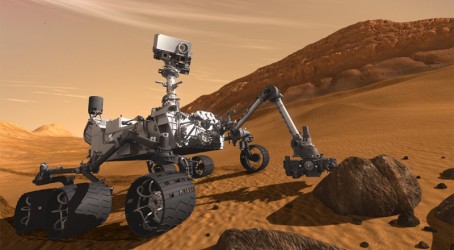Articles
Man’s fascination with Mars goes back millennia. It is one of the nearest planets to earth and the best situated for observation. Mars is also one of the few heavenly bodies on which we see surface features; these have inspired the imagination of everyone from scientists to science-fiction writers.
The records of Martian observation date back to the second millennium BCE when Egyptian astronomers observed the planet and recorded its position. It was portrayed on the ceiling of the tomb of Seti I (1290-1279 BCE).
Aided by the telescope, Galileo observed the phases of Mars in 1610. Huygens produced the first sketches of surface detail in 1659, and in 1660 he suggested a rotation period of 24 hours. In 1783 Sir William Herschel detected seasonal variation in the sizes of the polar caps and determined the position of the axis of rotation.
In 1877 Giovanni Schiaparelli made the first comprehensive triangulation of the planet’s surface. He recorded line-like markings, which he called canali, meaning channels, but the term was mistranslated into English as canals. Because the term canal suggests intelligent life, this sparked ideas about life on Mars. Scientists later found that the channels were optical illusions. This was supported by the astronomer Vincenzo Cerulli’s observations in 1897.
The Soviets launched several spacecraft to explore Mars from 1960 to 1973. The most successful launches were in the early 1970s, when the orbiter spacecraft
started sending back images and data about Martian gravity and magnetic fields.
Nasa’s Jet Propulsion Laboratory made two attempts at reaching Mars in 1964. Mariner 3 and Mariner 4 were designed to carry out flybys of Mars. Mariner 3 was unsuccessful but Mariner 4 completed a 7½-month journey. It flew by Mars on 14 July 1965, providing the first close-up photographs of another planet.
In 1975 Nasa sent two space probes to Mars called Viking 1 and 2. Each craft was composed of an orbiter, designed to photograph the surface of Mars from orbit,
and a lander to study the surface of the planet.
The Mars Global Surveyor was a spacecraft developed by Nasa and launched in November 1996. It housed scientific instruments which collected data from the planet until November 2006. The Mars Pathfinder spacecraft landed on the planet in 1997. It consisted of a lander and a wheeled robotic rover called Sojourner.
Nasa’s Curiosity rover, launched on 26 November 2011, is the latest explorer of Mars. It landed on the surface on 6 August 2012. The rover’s goals are to investigate the climate and geology, see whether Mars ever supported life, and to perform habitability studies in preparation for human exploration.
The rover is slightly shorter, wider and taller than a small car. It carries 80kg of scientific instruments and is powered by a radioisotope thermoelectric generator. The generator obtains its power from radioactive decay of plutonium-236.
Curiosity has 17 cameras; an environmental monitoring system; an alpha-particle X-ray spectrometer device; an X-ray power diffraction and fluorescent instrument; a sample analysis instrument; a radiation detector; and a “dynamic albedo of neutrons” instrument for measuring hydrogen, or ice and water. Many of the instruments were developed and funded by agencies from different countries.
Budget restrictions are having an impact at Nasa while emerging nations have ambitions to explore space. So Martian rover research could become smaller-scale, more targeted, and sponsored and managed by a greater number of countries.
There are still many financial, engineering, physiological and psychological challenges to be overcome before manned missions become a reality. But it is hoped that the discoveries and technologies of astronomers, scientists and engineers will one day enable humans to walk on the red planet.
